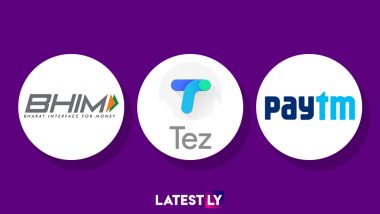New Delhi, February 20: Giving a major boost to digitalisation in India, banks and e-wallet companies have now integrated with the UPI platform for hassle-free transactions. Soon after Prime Minister Narendra Modi’s digitalisation drive in November 2016, government-backed payment wallet, BHIM (Bharat Interface for Money) took the nation on a joyride.
Payment wallets like Paytm, Google Tez, PhonePay have been enjoying the increased customer base since demonetisation was announced as online transactions have considerably gone up since then. The BHIM app allows users without a smartphone to carry out cashless transactions by simply dialling *99#. Leaving no stone unturned, Google too jumped in with its Tez application while Facebook-owned WhatsApp said it is piloting a payments service linked to UPI.
Paytm:
Digital payments firm Paytm has been on the go after the Prime Minister’s demonetisation drive. As per earlier reports, Paytm had added five million new users and made record transactions worth of Rs 120 crore every day untill January 2017. It must be noted that the app is available in different regional language. As of now, the user interface is available in English and ten different regional languages including Hindi, Tamil, Telugu, Gujarati, Marathi, Bengali, Kannada, Malayalam, Oriya and Punjabi. This gives Paytm a higher user base as there are no language barriers in using Paytm.
Unlike Google Tez, which relies on UPI and consequently third-party services and infrastructure, Paytm can control user experience from top to bottom. In addition to this, Paytm is widely known. Vijay Shekhar Sharma backed Paytm is approved as an operating unit for Bharat Bill Payment System, making it a secure way to pay for various bills. Paytm asks users to add money to ease the payments made to various merchants and also offers the options of booking movie tickets, recharge mobiles and DTH, pay bills, etc. with different cash back benefits.
BHIM:
Bharat Interface for Money (BHIM) is a payment app that lets you make simple, easy and quick transactions using Unified Payments Interface (UPI). You can make direct bank payments to anyone on UPI using their UPI ID or scanning their QR with the BHIM app. Users can also request money through the app from a UPI ID.
Pioneered and developed by National Payments Corporation of India (NPCI), BHIM is not a payment wallet which requires a prepaid payment, it essentially connects your bank accounts to make easier payments. The app can be accessed through various platforms, like UPI, IFSC and MMID and unique QR code. The app is connected to the user's Aadhaar number, making it more secure. The App also has a three-step security method for making payments, assuring us of its security. A negative point for BHIM will be the low transaction cut. BHIM App currently has a transaction limit of Rs 20,000 per day and the maximum amount per transaction is kept at Rs 10,000.
BHIM was launched by Prime Minister Narendra Modi on 30th December 2016 with an aim to bring in Financial Inclusion to the nation and a digitally empowered society. Now, the BHIM app has to fight with Google Tez to be the number one UPI app.
Google Tez:
Last year, Google’s launch of payments service Tez made India the first market in the world where global technology giants are competing with each coming day. Google Tez on Tuesday said that customers of about 90 utility firms including power, telecom and DTH, can now pay their bills online the app. “We are delighted to bring additional new functionality to our growing base of users on Tez. Today, we are adding a specially designed bill pay experience in Tez which will enable users to make a wide range of bill payments including electricity, water, gas, DTH, and insurance from the app," Diana Layfield, VP, Payments & Commerce, Next Billion Users at Google said in a statement.
As part of promoting cashless transactions and converting India into less-cash society, various modes of digital payments are available.
India’s digital payments revolution began in August 2016 with the launch of the Unified Payments Interface or UPI. The Digital India programme is a flagship programme of the Government of India with a vision to transform India into a digitally empowered society and knowledge economy. “Faceless, Paperless, Cashless” is one of the professed role of Digital India. With WhatsApp’s entry into the digital payments space, the incumbents have been a bit jittery. With close to 200 million monthly active users, WhatsApp is believed to disrupt the UPI-based digital payments industry, currently dominated by Paytm.
WhatsApp, the country’s most popular messaging app with over 200 million users, allows transferring money to WhatsApp contacts within a chat itself, making it convenient. And what gives it the biggest advantage is its reach. Google’s Tez too offers interesting features like cash mode by which users can connect with fellow Tez users in the vicinity using audio commands and send money directly to each other’s bank accounts. But it’s a standalone payments app which needs to be downloaded.
(The above story first appeared on LatestLY on Feb 21, 2018 04:01 PM IST. For more news and updates on politics, world, sports, entertainment and lifestyle, log on to our website latestly.com).













 Quickly
Quickly












